communicative-language-teaching交际语言教学法
交际教学法启示
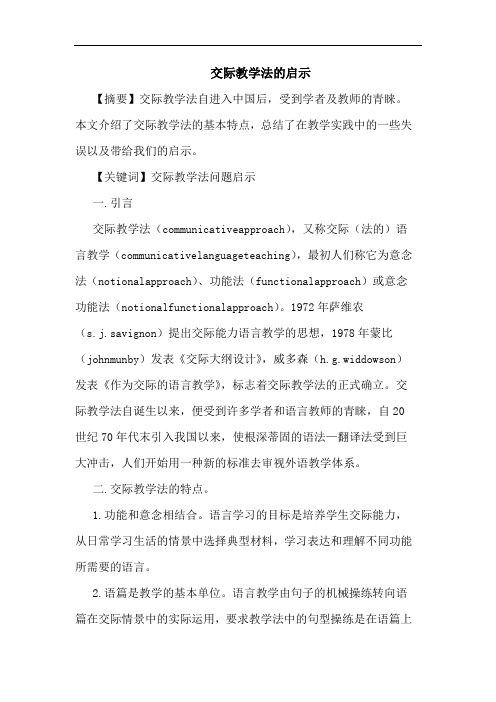
交际教学法的启示【摘要】交际教学法自进入中国后,受到学者及教师的青睐。
本文介绍了交际教学法的基本特点,总结了在教学实践中的一些失误以及带给我们的启示。
【关键词】交际教学法问题启示一.引言交际教学法(communicativeapproach),又称交际(法的)语言教学(communicativelanguageteaching),最初人们称它为意念法(notionalapproach)、功能法(functionalapproach)或意念功能法(notionalfunctionalapproach)。
1972年萨维农(s.j.savignon)提出交际能力语言教学的思想,1978年蒙比(johnmunby)发表《交际大纲设计》,威多森(h.g.widdowson)发表《作为交际的语言教学》,标志着交际教学法的正式确立。
交际教学法自诞生以来,便受到许多学者和语言教师的青睐,自20世纪70年代末引入我国以来,使根深蒂固的语法—翻译法受到巨大冲击,人们开始用一种新的标准去审视外语教学体系。
二.交际教学法的特点。
1.功能和意念相结合。
语言学习的目标是培养学生交际能力,从日常学习生活的情景中选择典型材料,学习表达和理解不同功能所需要的语言。
2.语篇是教学的基本单位。
语言教学由句子的机械操练转向语篇在交际情景中的实际运用,要求教学法中的句型操练是在语篇上下文中为表述意义和交际功能服务的。
3.教学过程交际化。
利用外语组织课堂进行教学,通过交流讨论和角色扮演实现外语教学过程交际化。
学生在言语交际活动中不仅要求语言形式的正确性,而且还应注意场合、符合说话人的身份等,得体地使用外语。
4.学生作为学习主体。
在以学生为中心的外语课堂上,教学目标是培养学生自主学习和学会学习的能力。
交际教学法反对命令、强迫和机械的训练,强调激发学习动机,消除焦虑情绪,鼓励学生积极参加言语交际活动,不苛求纠正语言错误。
三.交际教学法存在的问题交际教学法在短短时间内受到国内学者和教师的追捧,但是在实际教学实践中,交际教学法存在一些问题。
交际法

特点
1)以培养交际功能为宗旨 2)以功能意念为纲 3)教学过程交际化 4)以话语为教学的基本单位 5)单项技能训练与综合性技能训练相结合 6)对学习者在学习过程中出现的语言错误有一定的容忍度 7)交际法强调以学生为中心,强调教学要为学生的交际需要服 务
交际法的教学原则
意义原则 交际原则 任务原则
意义原则:教学材料、教学活动要有意义, 教学者要用有意义的语言促进语言学习。 交际原则:真正涉及交际的活动能促进语言 学习,因此课堂中要设计有情境的真正的交 际活动。 任务原则:语言是用来完成任务的,并且通 过任务来进行语言的学习。
功能意念大纲
功能:通过语言做成某件事或达成某 些目的。如:建议、请求、希望等, 可以用“why”来检验的。 意念:功能的内容,即人们在使用某 种语言完成某种功能时所涉及或处理 的概念及其间的关系。比如时间、空 间、数量、条件、因果等。是通过 what 和who来检验的。 意念分为普通意念和特殊意念。前者 多涉及抽象的时空数量等关系,后者 指具体词汇内容。
理论基础
交际法的语言学理论基础
交际法的心理学基础
交际法的语言学理论基础是20世纪
60年代兴 起70年代形成高潮的社会语言学。尤其是社 会语言学家海姆斯的交际能力理论和功能主 义语言学家韩礼德的功能语言理论和话语分 析理论,以及威多森的语言交际观 。
社会语言学家海姆斯在1972年首先提 出了“交际能力”这一著名的概念,这是交 际法所要达到的教学目的,也是交际法的语 言学理论基础。受其影响,交际法把语法看 作实现语言功能的手段。这一概念的提出与 乔姆斯基提出的“语言能力”形成了鲜明对 比。
交际法(Communicative Approach)
1、什么是交际法 2、交际法产生的背景 3、交际法的基础 4、交际法的特点 5、交际法的教学原则 6、交际法的要核及大纲 7、交际法的教学流程 8、交际法的评价
交际教学法

交际教学法Communicative Language Teaching一、引言交际教学法产生于二十世纪七十年代,现在已成为国内外众多学者研究的重点之一。
总体来说,交际教学法的发展有效的弥补了翻译法和认知法等教学方法只重语法规则而忽略语言使用的缺陷,极大了促进了英语语言教学的发展。
但是交际教学法在实施的过程当中还有许多问题应该注意。
交际教学法的特点为:坚持以学生为中心开展教学激发学生的学习兴趣;把握课堂教学的灵活性和趣味性;开展丰富多彩的课堂语言交际活动;进行语境化教学二、交际教学法的产生与发展历程交际教学法(Communicative Language Teaching)产生于二十世纪六七十年代。
1957年Chomsky认为语言结构理论已经难以解释语言的基本特点,他提出了语言能力(Linguistic Competence)和语言行为(Linguistic Performance)两个概念。
而Hymes (1972)认为,语言不仅包含语言知识(language knowledge),也应该包含语言应用能力(language use ability),因此他在Chomsky对语言能力和语言行为划分地基础之上提出了交际能力(Communicative Competence)。
Hymes认为,一个人语言掌握的好坏,不仅在于语法规则的正确,也在于能在特定的语境中恰如其分的运用语言。
这就扩大了语言和语言使用能力的内涵意义,涉及到了语言使用者语言之外的知识(陈坚林,2000)。
Halliday对Hymes提出的交际能力做了有益的补充,他为,语言是为交际服务的工具,教学不仅要教会学生正确的语法规则,更要培训学生如何使用语言达到交际的目的。
在此基础之上,以学生为中心,分析学生的交际需求和学习动机的教学实践和科研得以进一步发展,而实践和科研的成果又进一步促进了交际教学法理论的丰富和完善。
对交际教学法做出突出贡献的还有Widdowson、Richard和Schmidt。
交际法教学教案模版八篇
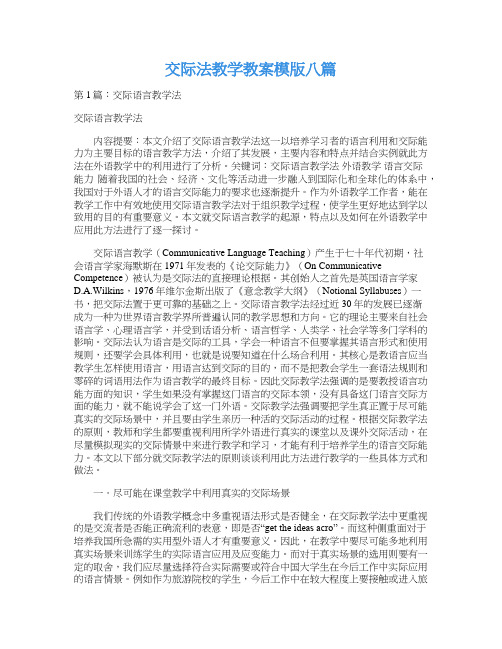
交际法教学教案模版八篇第1篇:交际语言教学法交际语言教学法内容提要:本文介绍了交际语言教学法这一以培养学习者的语言利用和交际能力为主要目标的语言教学方法,介绍了其发展,主要内容和特点并结合实例就此方法在外语教学中的利用进行了分析。
关键词:交际语言教学法外语教学语言交际能力随着我国的社会、经济、文化等活动进一步融入到国际化和全球化的体系中,我国对于外语人才的语言交际能力的要求也逐渐提升。
作为外语教学工作者,能在教学工作中有效地使用交际语言教学法对于组织教学过程,使学生更好地达到学以致用的目的有重要意义。
本文就交际语言教学的起源,特点以及如何在外语教学中应用此方法进行了逐一探讨。
交际语言教学(Communicative Language Teaching)产生于七十年代初期,社会语言学家海默斯在1971年发表的《论交际能力》(On Communicative Competence)被认为是交际法的直接理论根据。
其创始人之首先是英国语言学家D.A.Wilkins,1976年维尔金斯出版了《意念教学大纲》(Notional Syllabuses)一书,把交际法置于更可靠的基础之上。
交际语言教学法经过近30年的发展已逐渐成为一种为世界语言教学界所普遍认同的教学思想和方向。
它的理论主要来自社会语言学、心理语言学,并受到话语分析、语言哲学、人类学、社会学等多门学科的影响。
交际法认为语言是交际的工具,学会一种语言不但要掌握其语言形式和使用规则,还要学会具体利用,也就是说要知道在什么场合利用。
其核心是教语言应当教学生怎样使用语言,用语言达到交际的目的,而不是把教会学生一套语法规则和零碎的词语用法作为语言教学的最终目标。
因此交际教学法强调的是要教授语言功能方面的知识,学生如果没有掌握这门语言的交际本领,没有具备这门语言交际方面的能力,就不能说学会了这一门外语。
交际教学法强调要把学生真正置于尽可能真实的交际场景中,并且要由学生亲历一种活的交际活动的过程。
英语教学法流派

英语教学法流派
英语教学法流派是指不同的英语教学方法和策略的不同学派或流派。
以下是几个著名的英语教学法流派:
1. 语法翻译法(Grammar-Translation Method):这个流派追求学习者对语法知识的准确理解和应用,并强调翻译作为学习和练习语言的主要方法。
2. 魔音法(Audiolingual Method):这个流派主要关注口语交流和语音训练,通过大量的听力和口语练习来培养学习者的听说能力。
3. 自然法(Direct Method):这个流派强调使用英语进行交流和沉浸式学习,尽量避免使用学生的母语。
4. 情景教学法(Communicative Language Teaching):这个流派注重学习者的真实语言运用能力,通过创造真实和实用的沟通情境来提高学习者的交际能力。
5. 个别化教学法(Individualized Instruction):这个流派强调根据学习者的个体差异和需求来进行个性化的教学,注重学习者的自主性和主动性。
6. 启发式教学法(Discovery Learning):这个流派鼓励学习者通过自己的发现和探索来学习语言,注重学习者的自主学习和问题解决能力。
这些英语教学法流派有时可以结合使用,根据学生的需求和教学目标选择合适的方法和策略。
交际教学法(CommunicativeLanguageTeaching)简要回顾
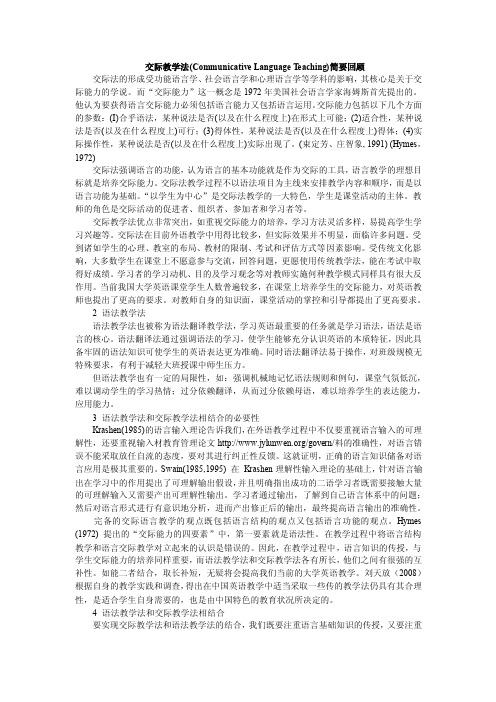
交际教学法(Communicative Language T eaching)简要回顾交际法的形成受功能语言学、社会语言学和心理语言学等学科的影响,其核心是关于交际能力的学说。
而“交际能力”这一概念是1972年美国社会语言学家海姆斯首先提出的。
他认为要获得语言交际能力必须包括语言能力又包括语言运用。
交际能力包括以下几个方面的参数:(I)合乎语法,某种说法是否(以及在什么程度上)在形式上可能;(2)适合性,某种说法是否(以及在什么程度上)可行;(3)得体性,某种说法是否(以及在什么程度上)得体;(4)实际操作性,某种说法是否(以及在什么程度上)实际出现了。
(束定芳、庄智象, 1991) (Hymes,1972)交际法强调语言的功能,认为语言的基本功能就是作为交际的工具,语言教学的理想目标就是培养交际能力。
交际法教学过程不以语法项目为主线来安排教学内容和顺序,而是以语言功能为基础。
“以学生为中心”是交际法教学的一大特色,学生是课堂活动的主体。
教师的角色是交际活动的促进者、组织者、参加者和学习者等。
交际教学法优点非常突出,如重视交际能力的培养,学习方法灵活多样,易提高学生学习兴趣等。
交际法在目前外语教学中用得比较多,但实际效果并不明显,面临许多问题。
受到诸如学生的心理、教室的布局、教材的限制、考试和评估方式等因素影响。
受传统文化影响,大多数学生在课堂上不愿意参与交流,回答问题,更愿使用传统教学法,能在考试中取得好成绩。
学习者的学习动机、目的及学习观念等对教师实施何种教学模式同样具有很大反作用。
当前我国大学英语课堂学生人数普遍较多,在课堂上培养学生的交际能力,对英语教师也提出了更高的要求。
对教师自身的知识面,课堂活动的掌控和引导都提出了更高要求。
2 语法教学法语法教学法也被称为语法翻译教学法,学习英语最重要的任务就是学习语法,语法是语言的核心。
语法翻译法通过强调语法的学习,使学生能够充分认识英语的本质特征,因此具备牢固的语法知识可使学生的英语表达更为准确。
CLT在外语教学中应用与推广的问题与对策-5页文档资料
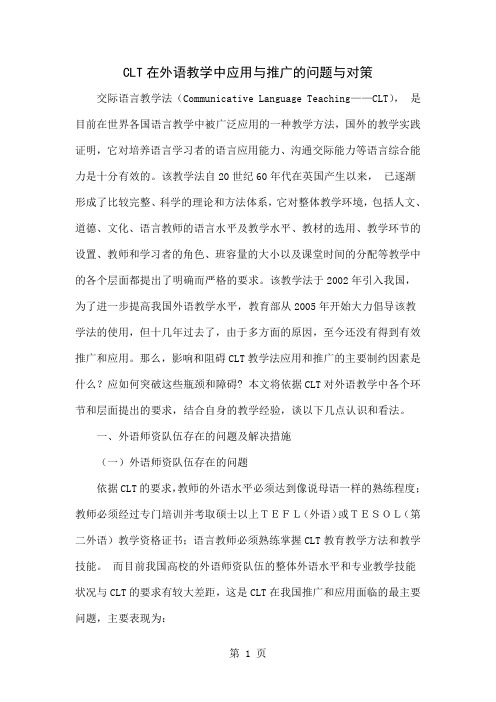
CLT在外语教学中应用与推广的问题与对策交际语言教学法(Communicative Language Teaching——CLT),是目前在世界各国语言教学中被广泛应用的一种教学方法,国外的教学实践证明,它对培养语言学习者的语言应用能力、沟通交际能力等语言综合能力是十分有效的。
该教学法自20世纪60年代在英国产生以来,已逐渐形成了比较完整、科学的理论和方法体系,它对整体教学环境,包括人文、道德、文化、语言教师的语言水平及教学水平、教材的选用、教学环节的设置、教师和学习者的角色、班容量的大小以及课堂时间的分配等教学中的各个层面都提出了明确而严格的要求。
该教学法于2002年引入我国,为了进一步提高我国外语教学水平,教育部从2005年开始大力倡导该教学法的使用,但十几年过去了,由于多方面的原因,至今还没有得到有效推广和应用。
那么,影响和阻碍CLT教学法应用和推广的主要制约因素是什么?应如何突破这些瓶颈和障碍? 本文将依据CLT对外语教学中各个环节和层面提出的要求,结合自身的教学经验,谈以下几点认识和看法。
一、外语师资队伍存在的问题及解决措施(一)外语师资队伍存在的问题依据CLT的要求,教师的外语水平必须达到像说母语一样的熟练程度;教师必须经过专门培训并考取硕士以上TEFL(外语)或TESOL(第二外语)教学资格证书;语言教师必须熟练掌握CLT教育教学方法和教学技能。
而目前我国高校的外语师资队伍的整体外语水平和专业教学技能状况与CLT的要求有较大差距,这是CLT在我国推广和应用面临的最主要问题,主要表现为:1. 外语水平与CLT的要求差距较大。
在我国的应试教育模式下,无论是中学还是大学,“听说”在外语教学中一直不是教学重点,因此,外语教师的外语听说能力在一开始就是弱项。
另外,外语教师在语音、语调以及外语使用的准确程度和熟练程度等方面的差异,都严重制约着CLT 的推广和应用。
2. 缺乏提高外语水平的语言环境。
Communicative Language Teaching

• 该方法主要是为有明确目的成年人建 立起来的一个教学体系,它是否适合 用于普通学校的外语教学? • 需要进一步处理好有错不纠与有错必 究的关系。 • 如何处理语言的流畅性和准确性获得 性的关系需要进一步探讨。 • 教学过程变成交际的过程,语言情景 总还带有些虚假性。
Thank you !
Conclusion
• Common to all versions of CLT is a theory of language teaching that starts from a communicative model of language and language use, and that seeks to translate this into a design for an instructional system, for materials, for teacher and learner roles and behaviors, and for classroom activities and techniques.
交际教学法的优点
• • • • • • 重视培养学生的交际能力 从学生实际需要出发,确定学习目标 以意念或功能为纲的新思路 重视教学过程的交际化 以话语为教学的基本单位 促进专业外语教学的蓬勃发展
交际教学法的不足
• 如何科学地、系统地统计语言功能项 目,有哪些确定语言功能项目的标准, 作为语言功能的范畴到底有多少,而 外语教学又需要多少语言功能范畴, 又怎样科学地安排它们的教学顺序, 还待进一步探讨,以更好的把握教材 内容。 • 如何协调语言功能与语言结构之间的 关系需要进一步探讨。
Communicative Language Teaching
[Communicative,Language,Teaching]交际语言教学法
![[Communicative,Language,Teaching]交际语言教学法](https://img.taocdn.com/s3/m/8cd5fab4804d2b160a4ec0ec.png)
[Communicative,Language,Teaching]交际语言教学法Chapter One Background Information and Definition of CLT1.1 Definition of CLTCommunicative Language Teaching is an approach to the teaching of second and foreign languages that emphasizes interaction as both the means and the ultimate goal of learning a language.1.2 Basic Features of CLTDavid Nunan (1991:279) lists five basic characteristics of Communicative Language Teaching:(1) An emphasis on learning to communicate through interaction in the target language.(2) The introduction of authentic texts into the learning situation.(3) The provision of opportunities for learners to focus, not only on the language but also on the learning process itself.(4) An enhancement of the learner“s own personal experiences as important contributing(5) An attempt to link classroom language learning with language activation outside the classroom.Chapter Two The Roles of Teachers and Learners in the Classroom2.1 The Role of the TeachersCommunicative language teaching is the generally accepted norm in the field of second language teaching. In CLT the teacher serves as more of a facilitator, allowing students to be in charge of their own learning.2.1.1 OrganizerIn the communicative language teaching, the teacher should organize the communicative activities, during which the students can have interactions according to the topics. Consequently, at the beginning of each class, the teacher should design various communicative activities that can arouse students’ interests.2.2.2 AdviserDuring the classroom communicative activities, the students may encounter different kinds of expressing difficulties, or sometimes even can not continue their conversation due to the limits of their language skills or lack of certain knowledge. When this happened, the teacher should help the students either by giving them the direct expressing or inspire them to express their ideas in another way.2.2.3 Facilitator and ParticipantBreen and Candlin pointed out that in communicative language teaching, there are two important roles the teacher should act as. The first role is to facilitate the communication process between all participants in the classroom, and between these participants and the various activities and texts. The second role is to act as an independent participant within the learning-teaching group. The latter role is closely related to the objectives of the first role and arises from it.2.2 The Role of the StudentsIn CLT, students practice real-life situations. In these exercises, the goal is for the student to communicate his or her needs and thoughts, without worrying about having perfect grammar. Consequently, in interactive classroom teaching, students can act as the master, cooperator and respondent in theclassroom teaching activities.2.2.1 ManagerIn CLT, the classroom is like a public place; every student can have a discussion on a certain topic or make a role play according to one situation. CLT can give students access to a chance of free learning. In this kind of class, the learning and communicating of students become an active and meaningful process.2.2.2 ParticipantDuring the process of communicative activities, students learn and use language by discussing, communicating and cooperating. That means, the language learning depends on the cooperation wi th other students. One’s expression or discussion can have an influence on others as well as being inspired by others. Thus, the whole process of learning a language is also the course of cooperation.Chapter Three Classroom Activities in CLTA wild variety of materials can be used to support communicative approaches to language teaching. The followings are some methods we can utilize during the communicative language teaching.3.1 Scrambled sentencesThe students are given a passage in which the sentences are in a scrambled order. This may be a passage they have worked with or one they have not seen before. They are told to unscramble the sentences so that the sentences are restored to their original order. This type of exercise teaches students about the cohesion and coherence properties of language.3.2 Picture strip storyMany activities can be done with picture strip stories. In theactivity, one student in a small group can be given a strip story. He shows the first picture of the story to the other members of his group and asks them to predict what the second picture would look like. An information gap exists-the students in the groups do not know what the picture contained. They have a choice as to what their prediction would be and how they would word it.3.3 Role playRole plays are very important in CLT because they give students an opportunity to practice communicating in different social contexts and in different social roles. Role plays can be set up so that they are very structured or in a less structured way. The latter is more in keeping with CLT, of course, because it gives the students more of a choice.Chapter Four Evaluations of CLTCommunicative Language Teaching focus on student-centered teaching practice. It simulates various situations according to real life, provides opportunities for students to communicate with each other.4.1 The Advantages of CLTThe interaction between teachers and students are greatly enhanced in CLT. One of the obvious characteristic of CLT is that the students are more responsible of their own learning than in a traditional teacher-centered classroom. The relationship between students and teachers is interactive and harmonious.Comminicative language teaching is a new approach in China, it emphasizes on the communicative competence and can stimulate students interest more than traditional teaching methods. However, it also has some shortcomings.4.2 The disadvantages of CLTOverdoing certain CLT features, for example engaging in real-life authentic language to the exclusion of helpful devices such as controlled practice, or vice versa. Moderation is needed in combination with common sense and a balanced approach.ConclusionIn present English teaching in China, Communicative Approach is a widely spread teaching method, but it still needs improving. Students“ need of language input and practice of language required teachers to balance. In teaching language skills, listening and speaking are much more emphasized than reading and writing. Through discussing aspects of teaching of English language system and skills, the dissertation shows that when helping students build a language system, teachers may adopt cognitive method in language teaching.BibliographyBrown, H. D.Teaching by Principles: An Interactive Approach to Language Pedagogy[M]. Englewood Cliffs,NJ: PrenticeHallRegents, 1994.Hymes, D. H. On Communicative Competence[A]. 1971.Jack C. Richards and Theodore S. Rodgers: Approaches and Methods in Language Teaching. Foreign Language Teaching and Research Press, 2008Wilkins, D. A.NotionalSyllabuses[M]. Oxford: Oxford University Press, 1976.。
交际法教学交际教学法
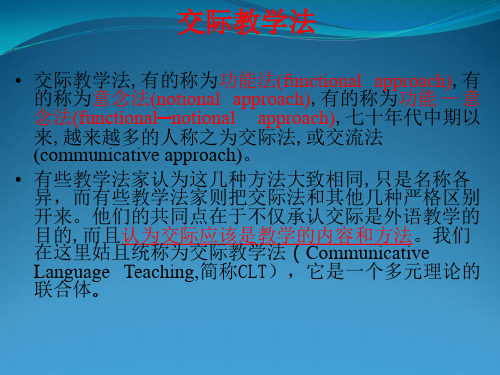
三、培养交际能力的策略
01
交际教学法强调根据学生具体的学 习需求设计各种交际情景,使学生 在多样化的交际活动中达到学习目 标。
既要传授语言 规则知识,又要 培养交际能力
利特伍德 (Littlewood)
结构活动
前交际活动
教师把交际能力分成具体的知识和技 能,指导学生进行语言形式操练,培养 学生听说读写单项能力。
强调文化的社会规则属性
四、交际教学法的优势和劣势
以功能为主实施教学内容, 很难保证语法教学的体系性
劣势
交际教学法教学评估困难
教师主导作用减弱,教材依赖度 降低,对教师提出更高的要求
在该教学法使用初期学生适应性差
五、教学建议
教学中以 交际为手 段,强化 交际能力
语言教学 评估体系 的重调
提升语言 教师的整 体素质
教学 • 5.在教学顺序上,交际法与结构法根本不同 • 6.学生处于更为积极主动的地位 • 7.在学习过程中不断使中介语言接近所学外语的规范
一、交际法的特点
1.交际教学法和主张结构教学法的人们对于语言的看 法不同
结构法把语言首先看成是语音、语法、词汇的总和, 认为学习语言首要的是学习语言的形式 交际法与此就根本不同,认为语言是交际的工具,学 会一种语言不仅要掌握其语言形式和使用规则,还要 学会具体运用,也就是说要知道在什么场合运用。
三、培养交际能力的策略
输入与输出并 举,提高英语运 用能力
03
• 首先,要让学生有足够的语言输入,通过听觉和视觉 大量感知语言材料,理解语言材料的意义,形式结构 和交际功能。
• 其次,要让学生将输入的语言材料和相关知识在多种 活动中反复操练、消化加工,使之进入长期记忆系统, 内化入学生已有知识结构之中,转化成听说读写单项 技能。
交际式教学法与任务型教学法在中国英语课堂的发展

交际式教学法与任务型教学法在中国英语课堂的发展许阳【摘要】CLT( Communicative Language Teaching)refers to a class teaching method that develops language learners' ability to communicate with the target language. TBLT( Task Based Language Teaching)emerges with the development of CLT,causing a reform of English teaching worldwide. However,there is the controversy over the standard definition of CLT and TBLT in domestic and foreign teaching field,especially its necessity and feasibility in China's English teaching. Therefore,this paper reviews and discusses the de-velopment of CLT and TBLT in China's English class so that the teaching concepts of both methods can be combined with China's Eng-lish class situation to make Chinese students have a better command of English knowledge.%交际外语教学法( CLT)是指发展语言学习者在情境中交流交际使用目标语言的能力的课堂教学法。
交际教学法

advantages
• ⑴Wider considerations of what is appropriate and what is accurate • ⑵Wider range of language • ⑶Realistic and motivating language practice • ⑷Drawing on learners’ knowledge and experience The Communicative Approach is now accepted by many applied linguists and classroom teachers as the most effective approach among those in general use.
disadvantages
• ⑴Difficult to tailor syllabus to students’ needs • ⑵Fossilization of learners’ errors • ⑶Unclear about how rules of use can be taught The Communicative Approach emphasizes learner’ needs.
Communicative Language Teaching (CLT)
Definition
• Communicative language teaching (CLT) is an approach to the teaching of second and foreign languages that emphasizes interacte ultimate goal of learning a language (Wilkins)
Unit-2-教学法part1-CLT讲解学习
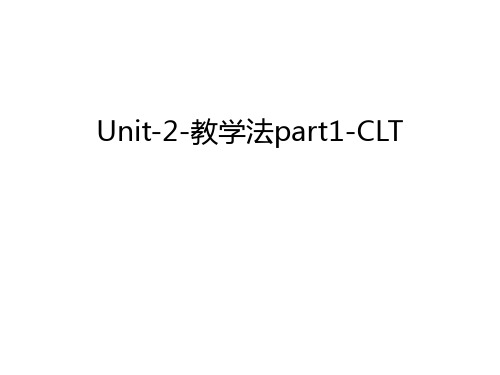
practical writings
High demand of the teacher???
Principles of CLT(Richards and Rodgers)
classroom activities 1. Communication principle
real communication (e.g. offer help in railway stations) 2. Task principle
receptive skills and
productive skills
To isolate language from context
Language is always used in a certain context.
Questions:
How to bridge the gap?
Introduction on CLT
linguistic competence
1. Meaning the ability to know the basic knowledge of the language itself, its formation and meaning 语言能力 spelling, grammatical structure, etc.
2. Implications for language teaching P19 a. pronounce the forms accurately b. build a range of vocabulary
pragmatic competence
1. Meaning the ability to use the language appropriately in different social contexts
communicativelangueteaching交际语言教学法

c o m m u n i c a t i v e l a n g ue t e a c h i n g交际语言教学法Revised final draft November 26, 2020C o m m u n i c a t i v e l a n g u a g e t e a c h i n g From Wikipedia, the free encyclopediaCommunicative language teaching(CLT), or the communicative approach, is antothat emphasizesas both the means and the ultimate goal of study. Language learners in environments utilizing CLT techniques learn and practice the target language through interaction with one another and the instructor, study of "authentic texts" (those written in the target language for purposes other than language learning), and use of the language in class combined with use of the language outside of class. Learners converse about personal experiences with partners, and instructors teach topics outside of the realm of traditional grammar in order to promote language skills in all types of situations. This method also claims to encourage learners to incorporate their personal experiences into their language learning environment and focus on the learning experience in addition to the learning of the target language.According to CLT, the goal of language education is the ability to communicate in the target language.This is in contrast to previous views in whichwas commonly given top priority.CLT also focuses on the teacher being a facilitator, rather than an instructor. Furthermore, the approach is a non-methodical system that does not use a textbook series to teach English but rather works on developing sound oral/verbal skills prior to reading and writing.Contents[hide]ooooooooBackground[]Societal influences[]Language teaching was originally considered a cognitive matter, mainly involving memorization. It was later thought, instead, to be socio-cognitive, meaning that language can be learned through the process of social interaction. Today, however, the dominant technique in teaching any language is communicative language teaching (CLT).It was's theories in the 1960s, focusing on competence and performance in language learning, that gave rise to communicative language teaching, but the conceptual basis for CLT was laid in the 1970s by linguists Michael Halliday, who studied how language functions are expressed through grammar, and Dell Hymes, who introduced the idea of a wider communicative competence instead of Chomsky's narrower linguistic competence.The rise of CLT in the 1970s and early 1980s was partly in response to the lack of success with traditional language teaching methods and partly due to the increase in demand for language learning. In Europe, the advent of the, an economic predecessor to the European Union, led to migration in Europe and an increased population of people who needed to learn a foreign language for work or for personal reasons. At the same time, more children were given the opportunity to learn foreign languagesin school, as the number of secondary schools offering languages rose worldwide as part of a general trend of curriculum-broadening and modernization, and foreign-language study ceased to be confined to the elite academies. In Britain, the introduction of, which offered foreign-language study to all children rather than to the select few in the elite, greatly increased the demand for language learning.This increased demand included many learners who struggled with traditional methods such as, which involves the direct translation of sentence after sentence as a way to learn language. These methods assumed that students were aiming for mastery of the target language, and that students were willing to study for years before expecting to use the language in real life. However, these assumptions were challenged by adult learners, who were busy with work, and some schoolchildren, who were less academically gifted, and thus could notdevote years to learning before being able to use the language. Educators realized that to motivate these students an approach with a more immediate payoff was necessary,and they began to use CLT, an approach that emphasizes communicative ability and yielded better results.Additionally, the trend ofin education provided further pressure for educators to change their methods. Progressivism holds that active learning is more effective than passive learning,and as this idea gained traction in schools there was a general shift towards using techniques where students were more actively involved, such as group work. Foreign-language education was no exception to this trend, and teachers sought to find new methods, such as CLT, that could better embody this shift in thinking.Academic influences[]The development of communicative language teaching was bolstered by new academic ideas. Before the growth of communicative language teaching, the primary method of language teaching was situational language teaching. This method was much more clinical in nature and relied less on direct communication. In Britain, applied linguists began to doubt the efficacy of situational language teaching. Thiswas partly in response to Chomsky's insights into the nature of language. Chomsky had shown that the structural theories of language prevalent at the time could not explain the variety found in real communication.In addition, applied linguists such as Christopher Candlin andobserved that the current model of language learning was ineffective in classrooms. They saw a need for students to develop communicative skill and functional competence in addition tomastering language structures.In 1966, linguist and anthropologistdeveloped the concept of. Communicative competence redefined what it meant to "know" a language; in addition to speakers having mastery over the structural elementsof language, they must also be able to use those structural elements appropriately in a variety of speech domains.This can be neatly summed up by Hymes's statement, "There are rules of use without which the rules of grammar would be useless."The idea of communicative competence stemmed from Chomsky's concept of theof an ideal native speaker.Hymes did not make a concrete formulation of communicative competence, but subsequent authors have tied the concept to language teaching, notably Michael Canale.Canale and Swain (1980) definedcommunicative competence in terms of three components: grammatical competence,competence, and strategic competence. Canale (1983)refined the model by adding discourse competence, which contains the concepts ofand.In the mid 1990s, the Dogme 95 manifesto influenced language teaching through themovement. This proposed that published materials stiflethe communicative approach. As such, the aim of the Dogme approach to language teaching is to focus on real conversations about practical subjects, where communication is the engine of learning. The idea behind the Dogme approach is that communication can lead to explanation, which will lead to further learning. This approach isthe antithesis of situational language teaching, which emphasizes learning through text and prioritizes grammar over communication.A survey of communicative competence by Bachman (1990) divides competency into the broad headings of "organizational competence", which includes both grammatical and discourse (or textual) competence, and "pragmatic competence", which includes both sociolinguistic and "" competence.Strategic competence is associated with theinterlocutors' ability in using communication strategies.CLT teachers choose classroom activities based on what they believeis going to be most effective for students developing communicative abilities in the target language (TL). Oral activities are popularamong CLT teachers, as opposed to grammar drills or reading and writing activities, because they include active conversation and creative, unpredicted responses from students. Activities vary based on the level of language class they are being used in. They promote collaboration, fluency, and comfort in the TL. The six activities listed and explained below are commonly used in CLT classrooms.Role-play[]Role-play is an oral activity usually done in pairs, whose main goal is to develop students' communicative abilities in a certain setting.Example:1.The instructor sets the scene: where is the conversation takingplace (E.g., in a café, in a park, etc.)2.The instructor defines the goal of the students' conversation.(E.g., the speaker is asking for directions, the speaker isordering coffee, the speaker is talking about a movie theyrecently saw, etc.)3.The students converse in pairs for a designated amount of time.This activity gives students the chance to improve their communication skills in the TL in a low-pressure situation. Most students are more comfortable speaking in pairs rather than in front of the entire class.Instructors need to be aware of the differences between a conversation and an utterance. Students may use the same utterances repeatedly when doing this activity and not actually have a creative conversation. If instructors do not regulate what kinds of conversations students are having, then the students might not be truly improving their communication skills.Interviews[]An interview is an oral activity done in pairs, whose main goal is to develop students' interpersonal skills in the TL.Example:1.The instructor gives each student the same set of questions toask a partner.2.Students take turns asking and answering the questions in pairs.This activity, since it is highly-structured, allows for theinstructor to more closely monitor students' responses. It can zonein on one specific aspect of grammar or vocabulary, while still being a primarily communicative activity and giving the students communicative benefits.This is an activity that should be used primarily in the lower levels of language classes, because it will be most beneficial to lower-level speakers. Higher-level speakers should be having unpredictable conversations in the TL, where neither the questions nor the answers are scripted or expected. If this activity were used with higher-level speakers it wouldn't have many benefits.Group work[]Group work is a collaborative activity whose purpose is to foster communication in the TL, in a larger group setting.Example:1.Students are assigned a group of no more than six people.2.Students are assigned a specific role within the group. (E.g.,member A, member B, etc.)3.The instructor gives each group the same task to complete.4.Each member of the group takes a designated amount of time towork on the part of the task to which they are assigned.5.The members of the group discuss the information they havefound, with each other and put it all together to complete thetask.Students can feel overwhelmed in language classes, but this activity can take away from that feeling. Students are asked to focus on one piece of information only, which increases their comprehension ofthat information. Better comprehension leads to better communication with the rest of the group, which improves students' communicative abilities in the TL.Instructors should to be sure to monitor that each student is contributing equally to the group effort. It takes a good instructorto design the activity well, so that students will contribute equally, and benefit equally from the activity.Information gap[]is a collaborative activity, whose purpose is for students to effectively obtain information that was previously unknown to them,in the TL.Example:1.The class is paired up. One partner in each pair is Partner A,and the other is Partner B.2.All the students that are Partner A are given a sheet of paperwith a time-table on it. The time-table is filled in half-way, but some of the boxes are empty.3.All the students that are Partner B are given a sheet of paperwith a time-table on it. The boxes that are empty on PartnerA's time-table are filled in on Partner B's. There are alsoempty boxes on Partner B's time-table, but they are filled inon Partner A's.4.The partners must work together to ask about and supply eachother with the information they are both missing, to completeeach other's time-tables.Completing information gap activities improves students' abilities to communicate about unknown information in the TL. These abilities are directly applicable to many real-world conversations, where the goal is to find out some new piece of information, or simply to exchange information.Instructors should not overlook the fact that their students need to be prepared to communicate effectively for this activity. They need to know certain vocabulary words, certain structures of grammar, etc. If the students have not been well prepared for the task at hand, then they will not communicate effectively.Opinion sharing[]Opinion sharing is a content-based activity, whose purpose is to engage students' conversational skills, while talking about something they care about.Example:1.The instructor introduces a topic and asks students tocontemplate their opinions about it. (E.g., dating, schooldress codes, global warming)2.The students talk in pairs or small groups, debating theiropinions on the topic.Opinion sharing is a great way to get more introverted students to open up and share their opinions. If a student has a strong opinion about a certain topic, then they will speak up and share.Respect is key with this activity. If a student does not feel like their opinion is respected by the instructor or their peers, then they will not feel comfortable sharing, and they will not receive the communicative benefits of this activity.Scavenger hunt[]A scavenger hunt is a mingling activity that promotes openinteraction between students.Example:1.The instructor gives students a sheet with instructions on it.(e.g. Find someone who has a birthday in the same month asyours.)2.Students go around the classroom asking and answering questionsabout each other.3.The students wish to find all of the answers they need tocomplete the scavenger hunt.In doing this activity, students have the opportunity to speak with a number of classmates, while still being in a low-pressure situation, and talking to only one person at a time. After learning more about each other, and getting to share about themselves, students will feel more comfortable talking and sharing during other communicative activities.Since this activity is not as structured as some of the others, it is important for instructors to add structure. If certain vocabulary should be used in students' conversations, or a certain grammar is necessary to complete the activity, then instructors should incorporate that into the scavenger hunt.Although CLT has been extremely influential in the field of language teaching, it is not universally accepted and has been subject to significant critique.In his critique of CLT,addresses both the theoretical and practical problems with CLT. In his critique, he mentions that CLT is not an altogether cohesive subject, but one in which theoretical understandings (by linguists) and practical understandings (by language teachers) differ greatly. Critique of the theory of CLT includes that it makes broad claims regarding the usefulness of CLT while citing little data, that it uses a large amount of confusing vocabulary, and that it assumes knowledge that is predominately language non-specific (ex. the ability to make educated guesses) is language specific.Swan suggests that these theoretical issues canlead to confusion in the application of CLT techniques.Where confusion in the application of CLT techniques is readily apparent is in classroom settings. Swan suggests that CLT techniques often suggest prioritizing the "function" of a language (what one can do with the language knowledge one has) over the "structure" of a language (the grammatical systems of the language).This priority can leave learners with serious gaps in their knowledge of the formal aspects of their target language. Swan also suggests that, in CLT techniques, whatever languages a student might already know are not valued or employed in instructional techniques.Further critique of CLT techniques in classroom teaching can be attributed to Elaine Ridge. One of her critiques of CLT is that it implies that there is a generally agreed upon consensus regarding the definition of "communicative competence," which CLT claims to facilitate, when in fact there is not. Because there is not such agreement, students may be seen to be in possession of "communicative competence" without being able to make full, or even adequate, use of the language. That an individual is proficient in a language does not necessarily entail that they can make full use of that language,which can limit an individual's potential with that language, especially if that language is an endangered language. This critiqueis largely to do with the fact that CLT is often highly praised andis popular, when it may not necessarily be the best method of language teaching.Ridge also notes that CLT has nonspecific requirements of its teachers, as there is no completely standard definition of what CLT is; this is especially true for the teaching of grammar (the formal rules governing the standardized version of the language in question). Some critics of CLT suggest that the method does not put enough emphasis on the teaching of grammar and instead allows students toproduce utterances which are grammatically incorrect as long as the interlocutor can get some meaning from them.Stephen Bax's critique of CLT has to do with the context of its implementation. Bax asserts that many researchers associate the use of CLT techinques with modernity and, therefore, the lack of CLT techniques as a lack of modernism. In this way, these researchers consider teachers or school systems which don't use CLT techniques as outdated and suggest that their students learn the target language "in spite of" the absence of CLT techniques, as though CLT were the only way to learn a language and everyone who fails to implement its techniques is ignorant and will not be successful in teaching the target language.。
交际法和任务型教学法及二者的比较

交际法和任务型教学法及二者的比较摘要:本文从产生和理论基础、教学理念、评价及在对外汉语教学中的应用几个方面了介绍了交际法和任务型教学法,并对二者在教学理念方面做出了比较。
关键字:交际法任务型教学法对外汉语教学一交际法的产生和理论基础交际法又称“交际语言教学”(communicative language teaching)。
较早称为“功能法”(functional approach)、“意念—功能法”(notional-functional approach),是以语言功能和意念项目为纲、培养在特定的社会语言环境中运用语言进行交际能力的一种教学法。
交际法产生于70年代初期西欧共同体国家,中心在英国,创始人为英国语言学家威尔金斯(D.A.Wilkins),代表人物还有英国的语言教学家亚历山大(L.G.Alexander)、威多森(H.G.Widdowson),荷兰的范埃克(J.A.VanEK)等。
交际法最有名的教材是《跟我学》。
(刘珣,2010)交际法语言学理论基础是20世纪60年代兴起70年代形成高潮的社会语言学。
交际法的语言观认为,语言是表达意义的系统,其基本功能是社会交际,语言学不应仅仅研究语言的形式,更要关注语言要完成的社会功能以及语言在人们社会交往中受到的制约因素,因此,第二语言教学的目的不仅是让学习者掌握语言规则、能正确地运用语言,更要掌握语言的使用规则,得体地运用语言。
交际法的心理学基础是人本主义心理学和20世纪60年代后期兴起的心理语言学。
交际法强调以学生为中心,首先要分析学习者对第二语言的需要,教学内容和教学方法的确定都必须从学习者的需要出发。
交际法还认为,学习者在言语中出现一些错误是正常的也是不可避免的现象,学习者所追求的不可能是完美无缺的交际,而只能是有缺陷的但有效的交际,因此,对学习者的语言错误不应苛求。
二交际法的教学理念交际法所遵循的教学基础原则是:1、强调学生的主动性和相互作用,而不只是以教师不中心,最大限度地保证学生的练习时间和练习量。
英语教学方法名称
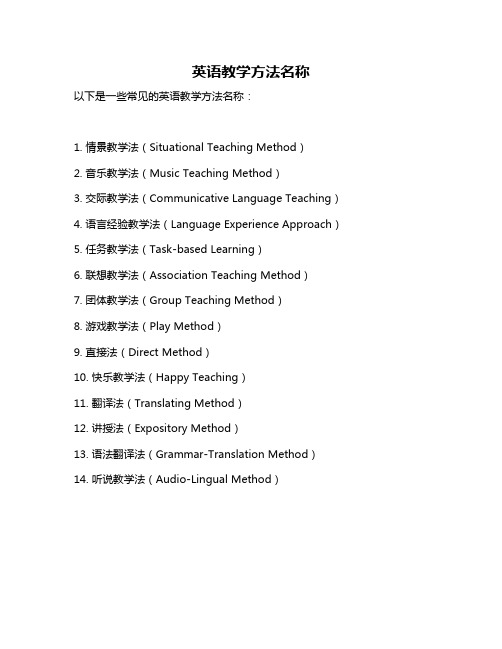
英语教学方法名称
以下是一些常见的英语教学方法名称:
1. 情景教学法(Situational Teaching Method)
2. 音乐教学法(Music Teaching Method)
3. 交际教学法(Communicative Language Teaching)
4. 语言经验教学法(Language Experience Approach)
5. 任务教学法(Task-based Learning)
6. 联想教学法(Association Teaching Method)
7. 团体教学法(Group Teaching Method)
8. 游戏教学法(Play Method)
9. 直接法(Direct Method)
10. 快乐教学法(Happy Teaching)
11. 翻译法(Translating Method)
12. 讲授法(Expository Method)
13. 语法翻译法(Grammar-Translation Method)
14. 听说教学法(Audio-Lingual Method)
这些教学方法在英语教学中起着重要的作用,每种方法都有其独特的特点和适用范围。
在实际教学中,教师可以根据学生的需求和实际情况选择合适的教学方法。
交际教学法(CLT)在英语口语教学中的应用

交际教学法(CLT)在英语口语教学中的应用发表时间:2020-01-16T11:25:29.420Z 来源:《知识-力量》2019年12月59期作者:高泉[导读] 交际语言教学法的理论衍生于社会语言学、心理语言学和乔姆斯基的转换生成法。
交际语言教学认为应当教学生怎样用语言达到交际的目的,而不仅仅是把教会学生一套语法规则和零碎的词语用法作为语言教学的目的。
而目前英语教学注重语法和句法结构,偏重于应试,不利于学生口语和交际能力的提高。
因此,对于交际语言教学法在口语教学中的应用探析就显得尤其重要。
(武汉学院英语系,湖北武汉 430212)摘要:交际语言教学法的理论衍生于社会语言学、心理语言学和乔姆斯基的转换生成法。
交际语言教学认为应当教学生怎样用语言达到交际的目的,而不仅仅是把教会学生一套语法规则和零碎的词语用法作为语言教学的目的。
而目前英语教学注重语法和句法结构,偏重于应试,不利于学生口语和交际能力的提高。
因此,对于交际语言教学法在口语教学中的应用探析就显得尤其重要。
关键词:交际教学法;英语教学;英语口语;现状分析随着全球化进程的快速发展,英语已成为全球化进程中的通用语言,因此掌握英语这门语言的交际口语能力显得尤其重要,已成为学生在踏入社会的必备技能。
然而,多年的教学实践发现大部分学生学完英语后,尽管通过了各种考试,却仍旧停留在哑巴英语的阶段,无法张口,因此英语口语教学的改革就显得尤为重要。
交际语言教学法侧重于培养学生用语言达到交际的目的,而不仅仅是把教会学生一套语法规则和零碎的词语用法作为语言教学的目的。
因此交际语言教学发对于改善学生口语能力是一种很值得深入探究的教学方式。
1.交际教学法交际语言教学法(Communicative Language Teaching Approach)起源于20世纪60年代后期,由美国社会语言学家、交际功能理论创始人海莫斯(D.H.Hymes)于 1972 年提出,交际语言教学侧重于培养学生用语言辅助交际本身,而不是将重点放在纠正学生语言和语法错误上,而是引导学生进行语言交流,更加侧重于语言的交流度上。
communicative language teaching 交际语言教学

Communicative desire
Content, not form
Variety of language
No teacher intervention
No materials control
What teachers and students should do?
For communicative activities to take place, the teacher needs to start from controlled structural activities to social problem solving activities.
The concept is supposed to be language teaching ideas, not an approach or method.
(交际语言教学是一种教学理 念,而不是一种有固定模式的教 学法)
Two Types
Functional communicatio n activities (功 能性交际活动) Social interaction activities (社 会交往活动)
Communicative Language Teaching(CLT)
• • • • • •
Definition Two types Features Six Criteria The advantages and disadvantages The characteristics of a successful speaking activity
Principles of the communicative approach
1. the communicative principle: Activities that involve real communication promote learning. 2. the task principle: Activities in which language is used for carrying out meaningful tasks promote learning (Johnson 1982).
- 1、下载文档前请自行甄别文档内容的完整性,平台不提供额外的编辑、内容补充、找答案等附加服务。
- 2、"仅部分预览"的文档,不可在线预览部分如存在完整性等问题,可反馈申请退款(可完整预览的文档不适用该条件!)。
- 3、如文档侵犯您的权益,请联系客服反馈,我们会尽快为您处理(人工客服工作时间:9:00-18:30)。
communicative-language-teac hing交际语言教学法Communicative language teachingFrom Wikipedia, the free encyclopediaCommunicative language teaching (CLT), or the communicative approach, isan approach to language teaching that emphasizes interaction as both the means and the ultimate goal of study. Language learners in environments utilizing CLT techniques learn and practice the target language through interaction with one another and the instructor, study of "authentic texts" (those written in the target language for purposes other than language learning), and use of the language in class combined with use of the language outside of class. Learners converse about personal experiences with partners, and instructors teach topics outside of the realm of traditional grammar in order to promote language skills in all types of situations. This method also claims to encourage learners to incorporate their personal2.5Opinion sharingo 2.6Scavenger hunt•3Critiques•4See also•5References•6Further readingBackground[edit]Societal influences[edit]Language teaching was originally considered a cognitive matter, mainly involving memorization. It was later thought, instead, to be socio-cognitive, meaning that language can be learned through the process of social interaction. Today, however, the dominant technique in teaching any language is communicative language teaching (CLT).[4]It was Noam Chomsky's theories in the 1960s, focusing on competence and performance in language learning, that gave rise to communicative language teaching, but the conceptual basis for CLT was laid in the 1970s by linguists Michael Halliday, who studied how languagefunctions are expressed through grammar, and Dell Hymes, who introduced the idea of a wider communicative competence instead of Chomsky's narrower linguistic competence.[4] The rise of CLT in the 1970s and early 1980s was partly in response to the lack of success with traditional language teaching methods and partly due to the increase in demand for language learning. In Europe, the advent ofthe European Common Market, an economic predecessor to the European Union, led to migration in Europe and an increased population of people who needed to learn a foreign language for work or for personal reasons. At the same time, more children were given the opportunity to learn foreign languages in school, as the number of secondary schools offering languages rose worldwide as part of a general trend of curriculum-broadening and modernization, and foreign-language study ceased to beconfined to the elite academies. In Britain, the introduction of comprehensive schools, which offered foreign-language study to all children rather than to the select few in the elite grammar schools, greatly increased the demand for language learning.[5]This increased demand included many learners who struggled with traditional methods such as grammar translation, which involves the direct translation of sentence after sentence as a way to learn language. These methods assumed that students were aiming for mastery of the target language, and that students were willing to study for years before expecting to use the language in real life. However, these assumptions were challenged by adult learners, who were busy with work, and some schoolchildren, who were less academically gifted, and thus could not devote years to learning before being able to use the language. Educators realizedthat to motivate these students an approach with a more immediate payoff was necessary,[6] and they began to use CLT, an approach that emphasizes communicative ability and yielded better results.[7]Additionally, the trend of progressivism in education provided further pressure for educators to change their methods. Progressivism holds that active learning is more effective than passive learning,[6] and as this idea gained traction in schools there was a general shift towards using techniques where students were more actively involved, such as group work. Foreign-language education was no exception to this trend, and teachers sought to find new methods, such as CLT, that could better embody this shift in thinking.[6]Academic influences[edit]The development of communicative language teaching was bolstered by new academic ideas. Before the growth of communicative language teaching, the primary method of language teaching was situational language teaching. This method was much more clinical in nature and relied less on direct communication. In Britain, applied linguists began to doubt the efficacy of situational language teaching. This was partly in response to Chomsky's insights into the nature of language. Chomsky had shown that the structural theories of language prevalent at the time could not explain the variety found in real communication.[8] In addition, applied linguists such as Christopher Candlinand Henry Widdowson observed that the current model of language learning was ineffective in classrooms. They saw a need for students to develop communicative skilland functional competence in addition to mastering language structures.[8]In 1966, linguist and anthropologist Dell Hymes developed the conceptof communicative competence. Communicative competence redefined what it meant to "know" a language; in addition to speakers having mastery over the structural elements of language, they must also be able to use those structural elements appropriately in a variety of speech domains.[2] This can be neatly summed up by Hymes's statement, "There are rules of use without which the rules of grammar would be useless."[5] The idea of communicative competence stemmed from Chomsky's concept of the linguistic competence of an ideal nativespeaker.[2] Hymes did not make a concrete formulation of communicative competence, but subsequent authors have tied the concept to language teaching, notablyMichael Canale.[9] Canale and Swain (1980) defined communicative competence in terms of three components: grammatical competence, sociolinguistic competence, and strategic competence. Canale (1983) refined the model by adding discourse competence, which contains the concepts of cohesion and coherence.[9]An influential development in the history of communicative language teaching was the work of the Council of Europe in creating new language syllabi. When communicative language teaching had effectively replaced situational language teaching as the standard by leading linguists, the Council of Europe made an effort to once again bolster the growth of the new method. This led to the Council of Europe creating a new language syllabus. Education was a highpriority for the Council of Europe, and they set out to provide a syllabus that would meet the needs of European immigrants.[8] Among the studies used by the council when designing the course was one by the British linguist, D. A. Wilkins, that defined language using "notions" and "functions", rather than more traditional categories of grammar and vocabulary. The new syllabus reinforced the idea that language could not be adequately explained by grammar and syntax, and instead relied on real interaction.[8]In the mid 1990s, the Dogme 95 manifesto influenced language teaching throughthe Dogme language teaching movement. This proposed that published materials stifle the communicative approach. As such, the aim of the Dogme approach to languageteaching is to focus on real conversations about practical subjects, where communication is the engine of learning. The idea behind the Dogme approach is that communication can lead to explanation, which will lead to further learning. This approach is the antithesis of situational language teaching, which emphasizes learning through text and prioritizes grammar over communication.[10]A survey of communicative competence by Bachman (1990) divides competency into the broad headings of "organizational competence", which includes both grammatical and discourse (or textual) competence, and "pragmatic competence", which includes both sociolinguistic and "illocutionary" competence.[11] Strategic competence is associated with the interlocutors' ability in using communication strategies.[11]Classroom activities[edit]CLT teachers choose classroom activities based on what they believe is going to be most effective for students developing communicative abilities in the target language (TL). Oral activities are popular among CLT teachers, as opposed to grammar drills or reading and writing activities, because they include active conversation and creative, unpredicted responses from students. Activities vary based on the level of language class they are being used in. They promote collaboration, fluency, and comfort in the TL. The six activities listed and explained below are commonly used in CLT classrooms.[6]Role-play[edit]Role-play is an oral activity usually done in pairs, whose main goal is to develop students' communicative abilities in a certain setting.[5]Example:1. T he instructor sets the scene: where isthe conversation taking place? (E.g., ina café, in a park, etc.)2. T he instructor defines the goal of thestudents' conversation. (E.g., thespeaker is asking for directions, thespeaker is ordering coffee, the speaker is talking about a movie they recentlysaw, etc.)3. T he students converse in pairs for adesignated amount of time.This activity gives students the chance to improve their communication skills in the TL in a low-pressure situation. Most students are more comfortable speaking in pairs rather than in front of the entire class.[5]Instructors need to be aware of the differences between a conversation and an utterance. Students may use the sameutterances repeatedly when doing this activity and not actually have a creative conversation. If instructors do not regulate what kinds of conversations students are having, then the students might not be truly improving their communication skills.[5] Interviews[edit]An interview is an oral activity done in pairs, whose main goal is to develop students' interpersonal skills in the TL.[12]Example:1. T he instructor gives each student thesame set of questions to ask a partner.2. S tudents take turns asking andanswering the questions in pairs.This activity, since it is highly-structured, allows for the instructor to more closely monitor students' responses. It can zone in on one specific aspect of grammar or vocabulary, while still being a primarilycommunicative activity and giving the students communicative benefits.[12]This is an activity that should be used primarily in the lower levels of language classes, because it will be most beneficial to lower-level speakers. Higher-level speakers should be having unpredictable conversations in the TL, where neither the questions nor the answers are scripted or expected. If this activity were used with higher-level speakers it wouldn't have many benefits.[12]Group work[edit]Group work is a collaborative activity whose purpose is to foster communication in the TL, in a larger group setting.[13] Example:1. S tudents are assigned a group of nomore than six people.2. S tudents are assigned a specific rolewithin the group. (E.g., member A,member B, etc.)3. T he instructor gives each group thesame task to complete.4. E ach member of the group takes adesignated amount of time to work onthe part of the task to which they areassigned.5. T he members of the group discuss theinformation they have found, with eachother and put it all together to complete the task.Students can feel overwhelmed in language classes, but this activity can take away from that feeling. Students are asked to focus on one piece of information only, which increases their comprehension of that information. Better comprehension leads to better communication with the rest of the group, which improves students' communicative abilities in the TL.[13]Instructors should to be sure to monitor that each student is contributing equally to the group effort. It takes a good instructor to design the activity well, so that students will contribute equally, and benefit equally from the activity.[13]Information gap[edit]Information gap is a collaborative activity, whose purpose is for students to effectively obtain information that was previously unknown to them, in the TL.[14]Example:1. T he class is paired up. One partner ineach pair is Partner A, and the other isPartner B.2. A ll the students that are Partner A aregiven a sheet of paper with a time-table on it. The time-table is filled in half-way, but some of the boxes are empty.3. A ll the students that are Partner B aregiven a sheet of paper with a time-tableon it. The boxes that are empty onPartner A's time-table are filled in onPartner B's. There are also emptyboxes on Partner B's time-table, butthey are filled in on Partner A's.4. T he partners must work together to askabout and supply each other with theinformation they are both missing, tocomplete each other's time-tables. Completing information gap activities improves students' abilities to communicate about unknown information in the TL. These abilities are directly applicable to many real-world conversations, where the goal is to find out some new piece of information, or simply to exchange information.[14]Instructors should not overlook the fact that their students need to be prepared to communicate effectively for this activity. They need to know certain vocabulary words, certain structures of grammar, etc. Ifthe students have not been well prepared for the task at hand, then they will not communicate effectively.[15]Opinion sharing[edit]Opinion sharing is a content-based activity, whose purpose is to engage students' conversational skills, while talking about something they care about.[15]Example:1. T he instructor introduces a topic andasks students to contemplate theiropinions about it. (E.g., dating, schooldress codes, global warming)2. T he students talk in pairs or smallgroups, debating their opinions on thetopic.Opinion sharing is a great way to get more introverted students to open up and share their opinions. If a student has a strong opinion about a certain topic, then they will speak up and share.[15]Respect is key with this activity. If a student does not feel like their opinion is respected by the instructor or their peers, then they will not feel comfortable sharing, and they will not receive the communicative benefits of this activity.[15]Scavenger hunt[edit]A scavenger hunt is a mingling activity that promotes open interaction between students.[16]Example:1. T he instructor gives students a sheetwith instructions on it. (e.g. Findsomeone who has a birthday in thesame month as yours.)2. S tudents go around the classroomasking and answering questions abouteach other.3. T he students wish to find all of theanswers they need to complete thescavenger hunt.In doing this activity, students have the opportunity to speak with a number of classmates, while still being in alow-pressure situation, and talking to only one person at a time. After learning more about each other, and getting to share about themselves, students will feel more comfortable talking and sharing during other communicative activities.[16]Since this activity is not as structured as some of the others, it is important for instructors to add structure. If certain vocabulary should be used in students' conversations, or a certain grammar is necessary to complete the activity, then instructors should incorporate that into the scavenger hunt.[16]Critiques[edit]Although CLT has been extremely influential in the field of language teaching,it is not universally accepted and has been subject to significant critique.[17]In his critique of CLT, MichaelSwan addresses both the theoretical and practical problems with CLT. In his critique, he mentions that CLT is not an altogether cohesive subject, but one in which theoretical understandings (by linguists) and practical understandings (by language teachers) differ greatly. Critique of the theory of CLT includes that it makes broad claims regarding the usefulness of CLT while citing little data, that it uses a large amount of confusing vocabulary, and that it assumes knowledge that is predominately language non-specific (ex. the ability to make educated guesses) is language specific.[17] Swan suggests that these theoretical issues can lead to confusion in the application of CLT techniques.[18]Where confusion in the application of CLT techniques is readily apparent is inclassroom settings. Swan suggests that CLT techniques often suggest prioritizing the "function" of a language (what one can do with the language knowledge one has) over the "structure" of a language (the grammatical systems of thelanguage).[18] This priority can leave learners with serious gaps in their knowledge of the formal aspects of their target language. Swan also suggests that, in CLT techniques, whatever languages a student might already know are not valued or employed in instructional techniques.[18]Further critique of CLT techniques in classroom teaching can be attributed to Elaine Ridge. One of her critiques of CLT is that it implies that there is a generally agreed upon consensus regarding the definition of "communicative competence," which CLT claims to facilitate, when in fact there is not. Because there is not such agreement, students may be seen to be inpossession of "communicative competence" without being able to make full, or even adequate, use of the language. That an individual is proficient in a language does not necessarily entail that they can make full use of that language, which can limit an individual's potential with that language, especially if that language is an endangered language. This critique is largely to do with the fact that CLT is often highly praised and is popular, when it may not necessarily be the best method of language teaching.[19]Ridge also notes that CLT has nonspecific requirements of its teachers, as there is no completely standard definition of what CLT is; this is especially true for the teaching of grammar (the formal rules governing the standardized version of the language in question). Some critics of CLT suggest that the method does not put enough emphasis on the teaching of grammar and insteadallows students to produce utterances which are grammatically incorrect as long as the interlocutor can get some meaning from them.[19]Stephen Bax's critique of CLT has to do with the context of its implementation. Bax asserts that many researchers associate the use of CLT techinques with modernity and, therefore, the lack of CLT techniques as a lack of modernism. In this way, these researchers consider teachers or school systems which don't use CLT techniques as outdated and suggest that their students learn the target language "in spite of" the absence of CLT techniques, as though CLT were the only way to learn a language and everyone who fails to implement its techniques is ignorant and will not be successful in teaching the target language.[3]See also[edit]。
